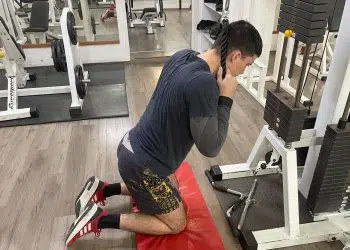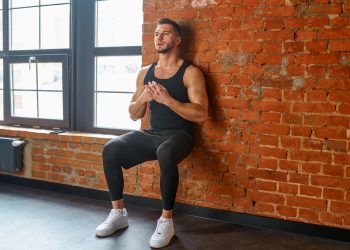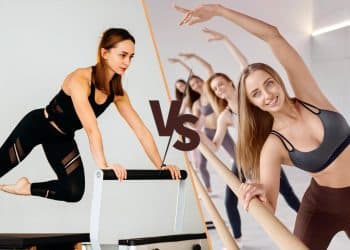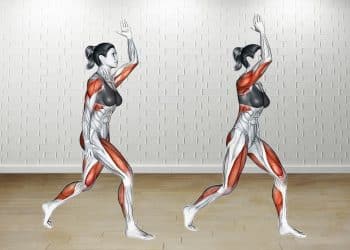Some exercises are iffy as to whether they’re effective or not, but seated leg raises will have your abs burning almost immediately. It’s one of those timeless classic moves that you can always fit into your midriff sessions and you’ll never be disappointed. Involving both the upper and lower body to target both ends of your core muscles, seated leg raises require focus and intensity which make them an all-around superior exercise. Plus we like the abundance of variations when you’re ready for a bigger challenge.
You only need a bench or similar raised platform or do it sitting on the ground.
Check out our full guide to seated leg raises for form tips, benefits, variations, best sets and reps ranges, and more.
In This Exercise:
- Target Muscle Group: Core
- Type: Strength and muscular development
- Mechanics: Isolation
- Equipment: Bench/similar platform
- Difficulty: Intermediate
How To Do Seated Leg Raises
A straightforward and non-complex exercise, seated leg raises can be learned with a little practice. However, that doesn’t mean they’re easy to do. You’ll need decent core strength to stabilize your spine, protect your back and fully engage the muscles plus you need mobile hips to do it effectively.
We included step-by-step instructions in detail below to ensure you get the most from this exercise.
Step 1: The setup
- Sit at the edge of a bench or similar object. Grip the end or sides of the bench depending on which is more comfortable and ergonomic for you.
Step 2: Pre-rep preparation
Pre-rep preparation is an important step before you begin any exercise. This includes cueing proper body positioning and engaging assisting muscles.
Level Up Your Fitness: Join our 💪 strong community in Fitness Volt Newsletter. Get daily inspiration, expert-backed workouts, nutrition tips, the latest in strength sports, and the support you need to reach your goals. Subscribe for free!
To prep:
- Sit up straight, tense your core muscles and recline your torso until it’s at a 45-degree angle to the bench. As you lay back, let your legs come up too but still keep them hanging off the end of the bench.
Step 3: Movement execution
Now that you’re set up and in the right position, you’re ready to do seated leg raises.
- Crunch your upper and lower body together as far as you comfortably can while maintaining a tense midsection. Squeeze your abs throughout the movement. Lean back and extend your legs forward then repeat for the desired number of repetitions.
See how it’s done via the following video.
Pro tip: Fully extend your legs for a great core challenge.
Benefits
Here are some reasons why seated leg raises can be a great addition to your core routine.
A classic ab builder
One of those exercises that’s been around since prehistoric times (not really) and goes far back beyond the days of bodybuilding and fitness legends. Seated leg raises and its variations are still widely used, recommended and programmed by top fitness professionals and trainers.
Trains the entire core
While seated leg raises mainly hit the abdominal muscles, you’re really getting a complete core workout. That doesn’t mean each muscle is trained equally and you do need to include other movements but outer and deeper core muscles are engaged and activated.
Perform better at other movements
Many don’t realize that the core muscles have a lot do with lifting performance. You need a solid midriff to support heavy loads during squats, deadlifts, rows, bench presses, and any compound lift. If not, you’d collapse and it’d be hard to stabilize the weight.
Lower back pain is also many times caused by a less than capable core or you’re just lifting too heavy which is equally not good. Leg raises are one exercises that will increase your core strength and help you to perform better.
Little to no equipment needed
Whether you use a bench, bed, or nothing at all, there are no limitations of this movement due to needing fancy or expensive exercise equipment. There are many options and variations which means you have no excuses.
Drawbacks
Here are some of the potential seated leg raise negatives.
Need a bench or similar platform
To do the version of seated leg raises talked about in this guide, you need a bench of some sort or a type of chair that will work. You can do it on the edge of a bed but there could be a few drawbacks to that. One, you don’t want to be sinking down into the bed so a firmer mattress is ideal, and two, it’s harder to grip the end of a bed due to the thickness and material. It can work though, you just want to maintain proper body positioning and a straight back.
Need a solid platform for ab training? These are our best sit up bench picks for 2022.
Requires a decently strong core
If you cannot maintain a straight upper body and rigid midsection, your back will pay for it during the exercise and later on. That’s why it’s good to have a little training experience and decent core strength before doing similar movements.
Typically, four to six months of dedicated total-body resistance training is enough to build a stronger core and to learn proper exercise form. Then you should be ready to take on seated leg raises and alternatives.
7 Variations
Seated leg raises are a classic ab exercise that work no doubt, however, at some point, they’ll become less challenging. Here are some awesome variations to mix things up and give yourself a more intense core workout.
Level Up Your Fitness: Join our 💪 strong community in Fitness Volt Newsletter. Get daily inspiration, expert-backed workouts, nutrition tips, the latest in strength sports, and the support you need to reach your goals. Subscribe for free!
1. Weighted seated leg raise
A quick and easy way to add more resistance to seated leg raises is to hold a small dumbbell between your ankles. You can also wear a pair of ankle weights too.
2. Floor leg raise
Performing leg raises on the floor has its advantages and disadvantage. The one drawback is that you don’t have a bench to grab onto, leaving you to focus solely on the technique. However, there are more pros than cons because floor leg raises recruit more stabilizers due to the greater balance requirements. Not to mention, you can do this variation anywhere.
3. Stability ball reverse crunch
While floor leg raises are more challenging than the seated variation, they don’t hold a candle to stability ball leg raises (it’s all in the name). You’re pretty much doing knee raises from an oversized beach ball that wants to roll around which will recruit your entire midsection to stabilize your body. You’ll need something behind your head to grab onto to keep you in place.
You can also do this variation from a bench or on the ground.
Here’s a video demonstration of this exercise. Note: Be careful not to let your legs too far down to avoid hyperextending your lower back.
4. Cocoons
Spread your wings like a butterfly with this core exercise variation named after the protective covering of insects prior to their transition. Cocoons are somewhat similar to seated leg raises in that it involves crunching both ends of your body toward each for maximum core engagement.
5. V-ups
V-ups err on the side of more advanced ab exercises (although not extreme). You need to be flexible and strong in the joints to do this exercise because the goal is to form a V shape with your body while sitting on your butt. While it primarily targets the ab muscles, V ups simultaneously engage hip flexors and quads too.
Learn how to do V-ups here.
6. Seated scissor leg raises
For some extra burn and lower ab muscle activation, perform seated leg raises combined with a scissor leg motion. Alternate crossing one foot over the other in a rapid motion as you lower and raise your legs.
7. Hanging leg raises
If you’re serious about your core training then hanging leg raises need to be in your rotation. There’s not a more challenging way to train your abs because there are so many versions of this variation that range from nice and easy to extremely difficult.
Using different positions combined with the weight of your lower body will create all of the resistance you need to keep challenging yourself.
Programming Seated Leg Raises In Your Ab Workouts
Seated leg raises and its variations need to have a place in your ab workouts. We’ll show you how we would do it but ultimately, how you program a movement in your training regime depends on your goals and training routine.
Best way to train abs
The following information explains how we would structure an ab workout based on anatomy and movement difficulty. Just like other muscle groups, it’s best to want to start with the hardest exercises when you have the most strength and energy followed by easier and less energy-draining movements.
Below is a list of ab exercises in the order that we would perform them.
- Hanging leg raise or similar bodyweight variations – utilize the heavy weight of your legs when you’re freshest and strongest.
- Leg raise with rotation (e.g, ab circles seated on butt) – involve rotation and total body stabilization to hammer the lower abs and obliques.
- Rotation/oblique-focused (e.g, Russian twists)
- Bottom and top half (e.g., seated leg raises) – engage both ends of your core.
- Top-down (e.g., basic ab crunch, kneeling cable crunch) – load the upper abs
- Planks – challenge your static core strength to finish your core workout
Optimal Sets and Reps
Keep in mind, it’s not as easy to determine a sets and reps range with bodyweight exercises. That’s because the resistance is fixed. However, abs typically benefit more from a higher rep range.
- We recommend 2-3 sets of 12-25 reps for seated leg raises.
If you need more resistance, try one of the included variations or add a dumbbell between your ankles.
Abs Circuit Workout: Training and Nutrition Tips for a Six-Pack
Muscles Worked
Below we’ve included brief descriptions of the muscle involved in seated leg raises because It’s helpful to know where to place your focus during any given exercise for best results.
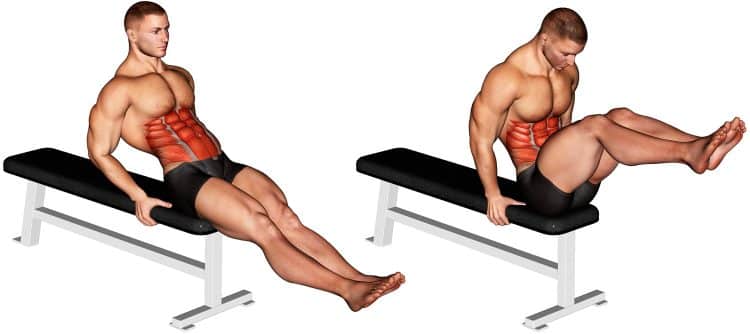
- Core/abs – Leg raises are of the best core and ab exercises that you can do. These muscles stand out on the midsection when there’s little body fat and they do give a complete look to a muscular physique. The abdominals and hip flexors help to facilitate this movement of crunching the upper and lower body together.
- Iliopsoas – The hip flexors are heavily involved in leg raise variations. Iliopsoas, the primary and strongest hip flexor; consists of a major and minor psoas muscles and iliacus. (2) Having strong, healthy hip flexors allows us to bring the thigh higher than hip level, helping us to maximize the activation of our core muscles. It’s an important muscle for standing, walking and running. So having strong and functional hip flexors is crucial to movement.
Bottom Line
Few ab exercises offer such a powerful combination of convenience, versatility, and effectiveness as seated leg raises and its variations. You’ll find that most, if not all ab workout routines include them and that’s for good reason, they work! Give seated leg raises a try next time you train your core muscles and take advantage of the more challenging versions to maximize your ab muscles development.
Use this guide to help you program seated leg raises into your core training sessions!
Interested in measuring your progress? Check out our strength standards for Bench Press, Cable Crunch, Deadlift, and more.


